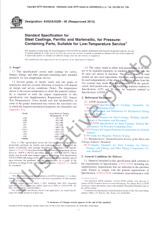We need your consent to use the individual data so that you can see information about your interests, among other things. Click "OK" to give your consent.
ASTM D8345-21
Standard Test Method for Determination of an Emission Parameter for Phthalate Esters and Other Non-Phthalate Plasticizers from Planar Polyvinyl Chloride Indoor Materials for Use in Mass Transfer Modeling Calculations
Translate name
STANDARD published on 1.3.2021
The information about the standard:
Designation standards: ASTM D8345-21
Publication date standards: 1.3.2021
SKU: NS-1049985
The number of pages: 16
Approximate weight : 48 g (0.11 lbs)
Country: American technical standard
Category: Technical standards ASTM
Annotation of standard text ASTM D8345-21 :
Keywords:
indoor air quality, plasticizers, small-scale environmental test chamber, SVOCs,
Additional information
| Significance and Use |
|
5.1?The conventional approach for characterizing VOC emissions from building materials and products (for example, Test Methods D6007 and D8142; Practices D6177, D6330, D6670, D6803, D7143; Guide D5116; and ISO 16000-6 standards) results in modeling VOC emissions in the indoor environment using area-specific emission rates (?g h-1 m-2). These approaches work for most chemicals classified as VOCs, because most VOC emissions are controlled by the internal mass transfer processes (diffusion of the chemical through the material) and most VOCs sorb to minimal extent to chamber walls. Hence, chamber area-specific emission rates can be directly applied to models of indoor environments. 5.2?In contrast, chemicals classified as SVOCs will sorb strongly to chamber walls and are controlled by the external mass transfer process (migration through the air boundary layer on the material surface). When used for the equilibrium gas phase concentration of certain SVOCs above source materials, conventional chamber emission characterization approaches are typically time-consuming taking up to several months due to sorption of analytes to chamber walls. Due to SVOCs external mass transfer limitation, the SVOC area-specific emission rate (?g h-1 m-2) measured in a test chamber can be different from that for the same material in a real indoor environment. To accurately model SVOC concentrations in indoor environments, a mass transfer approach to determine gas phase concentrations in equilibrium with the material phase is needed. 5.3?Modeling emissions in a real environment using a mass transfer framework requires knowledge of the convective mass transfer coefficient (hm), the initial SVOC concentration in the material (Co), the diffusion coefficient in the material (D), and the concentration in the air immediately above the material surface (y0). Typically, the convective mass transfer coefficient, hm, and diffusion coefficient, D, can be estimated. The initial concentration in the material (Co) can be determined by means of extraction. EPA Method 8270E and Test Method CPSC-CH-C1001-09.4 can be used to determine bulk concentrations of phthalates in materials. The unknown mass transfer emission parameter required for exposure modeling in full-scale environments is the gas-phase concentration of SVOCs in equilibrium with the material phase (y0). This standard describes procedures for rapidly determining y0 for phthalates from indoor planar polyvinyl chloride materials. 5.4?This method may be used to provide manufacturers, builders, and end users with some of the input data (y0) required for models used to evaluating the impact of indoor planar, polyvinyl chloride materials on concentrations of indoor SVOCs as well as for mass transfer exposure models. 5.5?This method assumes that an instantaneous equilibrium exists between gas phase and material surface. This assumption has been made for a variety of SVOC mass transfer emission and exposure models (see Little et al. 1.1?Planar polyvinyl chloride (vinyl) indoor materials can contain semi-volatile organic compounds (SVOCs), such as phthalate esters and other non-phthalate plasticizers, that can emit into indoor air. Phthalate esters and other non-phthalate plasticizers that have been measured using this standard are listed in Table 1 and are referred to as SVOCs in the remainder of this document. 1.2?The SVOCs listed in Table 1 are present in a wide range of products and not limited to planar polyvinyl chloride (vinyl) indoor materials. This standard discusses specific planar polyvinyl chloride materials due to method development and associated quality control data produced from testing these materials. The materials inclusion in this standard does not indicate the SVOC source strength of specific polyvinyl chloride planar materials relative to other products. 1.3?This method describes the design of a 1 L environmental chamber with minimal exposed chamber walls. 1.4?This method measures the steady-state gas phase concentration of SVOCs in the chamber. Samples of products are tested at specified conditions of temperature, airflow rate, and elapsed time in a specially designed chamber with dry air. Air samples are collected periodically using sorbent sampling tubes at the chamber exhausts at controlled flow rates, and then analyzed by thermal desorption-gas chromatography-mass spectrometry (TD-GC-MS). 1.5?This method determines the SVOC convective gas-phase mass transfer coefficient across the material surface, hm, from the known dimethyl phthalate mass transfer coefficient in the chamber 1.6?Using the steady-state gas phase concentration and mass transfer coefficient, the method estimates the gas-phase concentration of SVOC in equilibrium with the material phase (1.7?The results for gas phase concentration change in the chamber with time, steady-state gas phase SVOC concentrations (yss), and 1.8?The values stated in SI units are to be regarded as standard. No other units of measurement are included in this standard. 1.9?This standard does not purport to address all of the safety concerns, if any, associated with its use. It is the responsibility of the user of this standard to establish appropriate safety, health, and environmental practices and determine the applicability of regulatory limitations prior to use. 1.10?This international standard was developed in accordance with internationally recognized principles on standardization established in the Decision on Principles for the Development of International Standards, Guides and Recommendations issued by the World Trade Organization Technical Barriers to Trade (TBT) Committee. |
We recommend:
Updating of laws
Do you want to be sure about the validity of used regulations?
We offer you a solution so that you could use valid and updated legislative regulations.
Would you like to get more information? Look at this page.




 Cookies
Cookies
